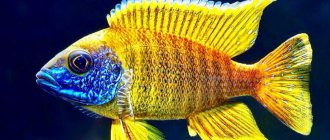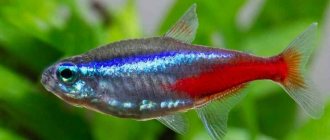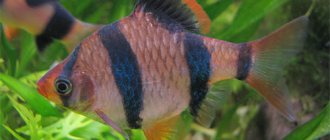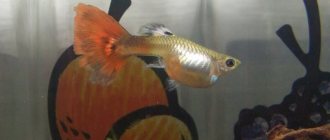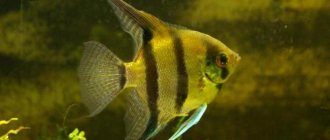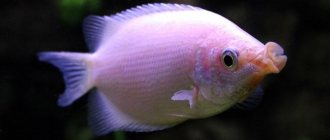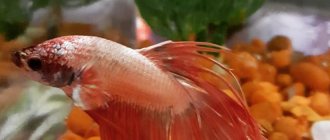The second name of this fish is SAE, from English. Siamese algae eater - Siamese algae eater. Representatives of the species have a peaceful disposition, modest size, they are considered excellent aquarium cleaners, hardworking and insatiable. For such qualities, the Siamese algae eater has gained popularity among aquarists around the world. However, when buying, you should take a closer look at your future pets; often these fish are passed off as the Siamese flying fox or the false Siamese algae eater. How not to confuse this hard-working fish with a false inhabitant, and what is known about Siamese algae eaters?
Habitat in nature
This inhabitant comes from Southeast Asia. The fish are found in Sumatran, Indonesian, and Thai reservoirs. The algae eater prefers to live in rivers and streams with intense currents and a hard, rocky bottom surface. At the bottom, in addition to cobblestones, there should be a lot of snags and submerged rhizomes - these fish love this environment and feel comfortable.
Due to the low water level and its transparency, algae actively grow in the reservoir, which is the main diet of the Siamese algae eater. Researchers believe that these underwater inhabitants are able to migrate during the dry season, moving to bodies of water with deep and muddy water.
Gyrinocheilus
Or as it is also called the Chinese algae eater. A typical representative of algae eaters, Gyrinoheilus lives in fast rivers and has adapted to scrape hard growths from stones.
He is quite large, and the saddest thing is that he is pugnacious. And his character forces him to fight not only with his own kind, but also with other fish, especially if they are similar in appearance to him.
And old girinocheilus practically stop eating algae and switch to live food or attack large fish and eat their scales.
Natural color
External features
The fish of this species is a bottom dweller, which in aquarium conditions grows no more than 10 cm long. The body of individuals is elongated, shaped like a block, covered with scales in grayish-green-brownish tones.
The fins , including the caudal one, are transparent. A black stripe in the form of an uneven zigzag runs from the fish’s mouth to the caudal fin. If the algae eater is stressed or frightened, the longitudinal stripe turns light gray. The jaw apparatus of individuals has an amazing structure - the oral cavity is equipped with small antennae, which the fish use to scrape off algae without harming the plant.
Very often, the Siamese algae eater is confused with Siamese flying foxes, or in other words, false algae eaters. But you can still distinguish a fox. Flying foxes have a more aggressive disposition and are not suitable for keeping in a community aquarium. In addition, you should not expect high performance from such inhabitants - they eat algae without much enthusiasm.
In nature, foxes and algae eaters coexist well, and mixed flocks of young individuals of both species are often found. But still, most of the fish found on sale are real. To avoid mistakes, it is worth knowing about the following differences:
- The horizontal stripe of the false algae eater runs only along the body, ending at the base of the caudal fin, while the true representative also has it on the tail;
- a real “Siamese” has a zigzag stripe;
- the false algae eater can be recognized by its mouth, which looks like a pinkish ring;
- The “real” fish has two black, inconspicuous antennae, while the false one has four.
But if the fish are so similar, why be upset about their different appearance? As already noted, chanterelles are not so hardworking and quarrelsome, which makes it difficult to keep them in a common tank.
General characteristics of eaters
One of the traditional methods of control is the breeding of fish, snails and shrimp that eat algae. The most effective use is of inhabitants that have an oral cavity adapted for scraping off fouling.
These creatures do not allow algae to actively reproduce and form colonies. They also help clean the aquarium of the remains of rotten plants and traces of treatment with special means. Next, we will consider the types of algae eaters in the aquarium, the features of their maintenance, the advantages and disadvantages of each type.
Habitat of Siamese algae eaters at home
In nature, fish grow up to 15 cm in length, but aquarium inhabitants become smaller and 7-10 cm individuals are more common. To contain them, you will need a tank with a volume of at least 100 liters. SAE are not picky and adapt well to new, unusual conditions, but it is advisable to keep them in an environment as close to natural as possible. To do this you will need:
- create an imitation of a river with a current;
- line the rocky-sandy bottom with driftwood and large cobblestones;
- provide free space for swimming;
- decorate with large-leaved plants (2-3 per aquarium) - “Siamese” love to rest on the top leaves;
- adhere to certain requirements for water parameters: acidity must be neutral or slightly acidic, within 5-8.0; temperature – from 23° to 26°С; hardness 5-20 dh.
The tank must be equipped with a lid, since these fish are capable of jumping out. An alternative is to use floating vegetation that covers the water surface.
If SAE receive adequate nutrition, then they do not spoil healthy plants, but some individuals consider duckweed and water hyacinth to be a delicacy. Also, many owners notice that their charges eat moss: they love Javanese moss most of all, but they do not refuse other types. Most often, in aquariums with algae eaters, not a trace of moss remains.
Feeding
In their natural habitat, most of the fish's diet consists of plants. Therefore, the same feeding rules should be followed in the aquarium. The menu of the Siamese algae eater should include both greens and vegetables:
- Zucchini;
- Dill;
- Spinach;
- Cucumber;
- Salad;
- Cabbage;
- Dandelion leaves and flowers;
- Peas.
Before serving, vegetables must be doused with boiling water or cooked for 1 - 2 minutes.
The diet of any fish should be balanced. Therefore, despite the fact that the basis of the diet is plant foods, protein foods must also be included in the menu. Can be used:
- Cyclops;
- Artemia;
- Small crustaceans;
- Bloodworm;
- Tubifex.
Feeding is carried out once a day.
The use of special food is also allowed. This product already contains all the nutrients necessary for fish. Portions and feeding frequency are indicated on the packaging.
How do they reproduce and how long do they live?
It is impossible to obtain offspring of these fish in aquarium conditions; there is not a single documented case where breeders were able to breed Siamese algae eaters in captivity. Even if you provide future parents with suitable conditions and stimulate the process with hormones, there is no guarantee that fry will appear.
The eggs of these fish most often become infected with infections caused by pathogenic fungi and spoil before they are fully ripe. Individuals that go on sale are caught in the wild or bred in Southeast Asian fish farms, where strong hormonal drugs are used.
If you provide the fish with favorable conditions, their life expectancy can be about 10 years.
Reproduction
Does not reproduce in aquarium conditions. Caviar is extremely vulnerable to fungi and infections. The fry die at the maturation stage.
They often sell wild-caught fish. Despite the impossibility of breeding, the fish is often found on the shelves of pet stores.
Sex differences
Weak sexual dimorphism. The female is larger and more rounded than the male.
When purchasing, consult a specialist; it is difficult to notice the difference with the naked eye.
Who do they get along with?
SAE get along well with the same peace-loving, non-conflict fish, but it is better not to add inhabitants with veil fins to them - they can bite this beauty. Algae eaters do not have the best company with the following inhabitants:
- labeo - they are relatives who will conflict with each other over territory, and the fight can lead to the death of individuals;
- cichlids - these territorial fish show unprecedented aggression during the mating season. They terrorize all the inhabitants, and the algae eaters will also get it.
In addition, SAE males do not get along with each other; they constantly show territoriality and bully their fellows. Even two individuals are too much for one aquarium.
How and what to feed these fish
Already from the name it is clear that the main food of these inhabitants is algae. But in an artificial tank they usually do not have enough food, and the owners need to take care of feeding. SAEs are not particularly picky and will not refuse live, frozen diets or artificial foods.
The diet should be varied, it is recommended to include vegetables - pieces of cucumbers, zucchini, spinach leaves, but before serving they should be scalded with boiling water. The main positive quality of the “Siamese” is their ability to eat one of the main unwanted inhabitants of the aquarium – blackbeard algae, which is quite difficult to get rid of.
By the way, other fish do not touch these black-greenish threads. In order for SAE to show interest in them, they should not be fed “to the fullest”, keeping them in a half-starved state. Young fish are best at destroying harmful algae, while adult fish prefer live food.
Mollies
This is a less fastidious algae eater. A fish whose maintenance, according to aquarists, is much simpler. This is explained by the fact that mollies (mollies) eat all varieties of filamentous algae, and black beard, and will not refuse plaque on the walls of the aquarium.
However, their effectiveness is not very high, like that of Girinocheilus or Amano shrimp. Mollies are very often kept in herbal aquariums because they are almost always available in pet stores, which is especially important in cases of algae outbreaks.
Tendency to diseases
If you provide individuals with good care and suitable conditions, then thanks to their strong natural immunity, SAE will not get sick. If you do not take care of the cleanliness of the aquatic environment and feed the fish with low-quality food, then natural protection may not work. If the water contains a large amount of nitrates, which appear when plant and animal remains decompose, then the fish may develop bacterial or viral infections.
The owner should take a closer look at the pets, especially if they become lethargic or, on the contrary, begin to rush around the aquarium. External symptoms of the disease include rashes or plaque on the scales, bulging, hyperemic eyes, bruises near the gill valves.
Sometimes, to help the fish, it is enough to change the water and carry out general cleaning, which normalizes the condition of the fish. And if the disease progresses, antibiotic therapy will be required.
The Siamese algae eater is an unusual inhabitant who performs an important mission - saving an artificial pond from an “uninvited black beard.” In addition, these cute, nimble fish are a real decoration of the aquarium and bring life to it.
Otocinclus
Another algae-eating fish with a suction cup mouth. The most common is Otocinclus affinis. She also actively fights green plaque and xenococus. It is smaller in size than Gyrinoheilus and is less noticeable in the aquarium. Its length does not exceed 3 cm, which quite often attracts plant lovers in the aquarium.
Its effectiveness against algae is approximately equal to that of the previous representative of algae eaters, but otocinclus is less hardy and very sensitive to the composition of the water. Like most loricariid catfish, otocinclus does not tolerate large amounts of nitrates in water (10-20 mg/l). In this case, he becomes lethargic and may die. These fish should be kept at the rate of no more than one individual per 40-50 liters of water.
